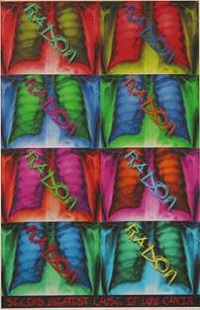Radon
Radon gas is produced by the decay of uranium, an element almost universally present in soil and rock. The gas moves slowly through the ground soil and can enter homes through openings or cracks in the foundations and construction joints. Over time, levels of radon gas in homes can build up.
The relationship between radon and lung cancer was first recognized in the 1950s, when it was observed that uranium miners exposed to very high levels of radon were dying of lung cancer at rates far greater than expected. Initially, the mechanism by which radon caused cancer was unknown. We now understand that radon gas is breathed into the lungs, where it begins to decay, releasing high-energy, radioactive particles (called alpha particles) that can damage lung tissue and cause lung cancer.
Today, most scientists believe that even relatively low-level exposure to radon increases lung cancer risk. The Environmental Protection Agency has established 4 pCi/L (picocuries of radon per liter of air) as the "action level" for radon reduction. The EPA estimates that if 1,000 people were exposed to this level of radon over a lifetime, between 13 and 50 would die of lung cancer as a result.
Radon levels vary from location to location, depending primarily on the amount of uranium in the soil. Los Angeles County, for example, is not considered to have particularly high levels of radon, with approximately one percent of homes believed to have levels above the EPA's action level. Riverside and San Bernardino Counties are estimated to have levels comparable to those in Los Angeles; levels in Orange County are thought to be lower. Ventura County, on the other hand, is considered a high radon area. In one survey, over 14 percent of the homes in certain parts of the county had elevated levels.
The EPA recommends radon testing even in areas with relatively low radon levels, such as Los Angeles. Testing is done by placing a small radon-sensitive device on the wall of your home. After a period of time-ranging from several days to several months-the detector must be sent to a laboratory, where the actual radon exposure is calculated.
Two types of tests are available. Short-term tests expose the detector for less than 90 days; long-term tests can extend to one year. Because radon levels vary with the season, short-term measurements can sometimes be misleading. Short-term test performed in the summer, for example, may underestimate your exposure; those taken in the winter can overestimate it. Although results are not quickly available with long-term tests, they do provide a better estimate of your year-round exposure. The EPA recommends that you begin with a short-term test. If the result of that test is 4 pCi/L or higher, the measurement should be repeated for confirmation.
You can have your home tested by a state-certified expert or by ordering a Radon Test Kit. Be sure to buy a home test kit that meets EPA requirements and follow the instructions that come with it.
Select a frequently used room on the lowest lived-in level of the house (for example, if you converted the basement into a bedroom or playroom, the test should be done there). Place the detector on a wall at least 20 inches above the floor and well away from windows and doors. Leave the detector undisturbed for the appropriate amount of time, and then send it promptly to the laboratory.
If you find that the radon level in your home is 4 pCi/L or higher, you should take steps to lower it. Sometimes, reducing radon levels is as simple as sealing foundation cracks or improving ventilation in your home; in other cases, more extensive work may be necessary. To find out more about radon reduction and to obtain a list of radon-mitigation companies in your area, contact the California Indoor Radon Program at 800-745-7236 or the National Safety Council's Radon Hotline at (800) SOS-RADON(767-7236).
Links
- Radon Fact Sheet - Los Angeles County Department of Public Health
- California Indoor Radon Program - California Department of Public Health
- Radon - American Lung Association
- Radon and Cancer - American Cancer Society
- Radon and Cancer - National Cancer Institute
- January is National Radon Action Month - National Safety Council
- Basic Radon Facts - U.S. Environmental Protection Agency
- Radon - U.S. Environmental Protection Agency
- Manual Informativo Sobre El Radón - U.S. Environmental Protection Agency
- Publications about Radon - U.S. Environmental Protection Agency
- Radon - U.S. National Library of Medicine and National Institutes of Health
- ToxFAQs™ for Radon - Agency for Toxic Substances and Disease Registry
- Radon-Resistant New Construction for Home Buyers - U.S. Environmental Protection Agency
- Radon and Real Estate - California Department of Public Health
- Radon in Water - California Department of Public Health
- Certified Radon Services Providers - California Department of Public Health





